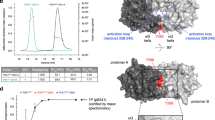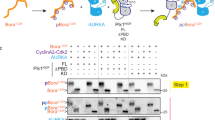Abstract
INTRACELLULAR signalling following mitogenic stimulation of quiescent cells involves the initiation of a phosphorylation cascade that leads to the rapid and reversible activation of the mitogen-activated protein (MAP) kinases ERK1 and ERK2 (refs 1,2). MAP kinase activation is mediated by dual phosphorylation within the motif Thr-Glu-Tyr by MAP kinase kinase (MEK)3. Following activation, the MAP kinases translocate into the nucleus where they phosphorylate several transduction targets, including transcription factors4–7. We have previously identified PAC1 as an immediate-early mitogen-inducible tyrosine phosphatase in nuclei of T cells8. Here we present several lines of evidence indicating that PAC1 is a physiologically relevant MAP kinase phosphatase. Recombinant PAC1 in vitro is a dual-specific Thr/Tyr phosphatase with stringent substrate specificity for MAP kinase. Constitutive expression of PAC1 in vivo leads to inhibition of MAP kinase activity normally stimulated by epidermal growth factor, phorbol myristyl acetate, or T-cell receptor crosslinking. The inactivation of MAP kinase by PAC1 results in inhibition of MAP kinase-regulated reporter gene expression.
This is a preview of subscription content, access via your institution
Access options
Subscribe to this journal
Receive 51 print issues and online access
$199.00 per year
only $3.90 per issue
Buy this article
- Purchase on Springer Link
- Instant access to full article PDF
Prices may be subject to local taxes which are calculated during checkout
Similar content being viewed by others
References
Ruderman, J. V. Curr. Opin. Cell Biol. 5, 207–213 (1993).
Nishida, E. & Gotoh, Y. Trends biochem. Sci. 18, 128–131 (1993).
Ahn, N. G., Seger, R. & Krebs, E. G. Curr. Opin. Cell Biol. 4, 992–999 (1992).
Gonzalez, F. A. et al. J. Cell Biol. 122, 1089–1101 (1993).
Alvarez, E. et al. J. biol. Chem. 266, 15277–15285 (1991).
Chen, R., Sarnecki, C. & Blenis, J. Molec. cell. Biol. 12, 915–927 (1992).
Davis, R. J. J. biol. Chem. 268, 14553–14556 (1993).
Rohan, P. J. et al. Science 259, 1763–1766 (1993).
Payne, D. M. et al. EMBO J. 10, 885–892 (1991).
Zheng, C.-F. & Guan, K.-L. J. biol. Chem. 268, 16116–16119 (1993).
Keyse, S. M. & Emslie, E. A. Nature 359, 644–647 (1992).
Marais, R., Wynne, J. & Treisman, R. Cell 73, 381–393 (1993).
Hill, C. S. et al. Cell 73, 395–406 (1993).
Graham, R. & Gilman, M. Science 251, 189–192 (1991).
Gille, H., Sharrocks, A. D. & Shaw, P. E. Nature 358, 414–417 (1992).
Charles, C. H., Abler, A. S. & Lau, L. F. Oncogene 7, 187–190 (1992).
Alessi, D. R., Smythe, C. & Keyse, S. M. Oncogene 8, 2015–2020 (1993).
Charles, C. H., Sun, H., Lau, L. F. & Tonks, N. K. Proc. natn. Acad. Sci. U.S.A. 90, 5292–5296 (1993).
Sun, H., Charles, C. H., Lau, L. F. & Tonks, N. K. Cell 75, 487–493 (1993).
Laemmli, U. K. Nature 227, 680–685 (1970).
Siegel, J. N. in Current Protocols in Immunology (eds Coligan, J. E., Kruisbeek, A. M., Margulies, D. H., Shevach, E. M. & Strober, W.) 11.2.4–11.2.17 (Wiley, New York, 1991).
Kameshita, I. & Fujisawa, H. Analyt. Biochem. 183, 139–143 (1989).
Seth, A., Gonzalez, F. A., Gupta, S., Raden, D. L. & Davis, R. J. J. biol. Chem. 267, 24796–24804 (1992).
Northwood, I. C., Gonzalez, F. A., Wartmann, M., Raden, D. L. & Davis, R. J. J. biol. Chem. 266, 15266–15276 (1991).
Harlow, E. & Lane, D. Antibodies. A Laboratory Manual 1–726 (Cold Spring Harbor Laboratory Press. New York, 1988).
Author information
Authors and Affiliations
Rights and permissions
About this article
Cite this article
Ward, Y., Gupta, S., Jensen, P. et al. Control of MAP kinase activation by the mitogen-induced threonine/tyrosine phosphatase PAC1. Nature 367, 651–654 (1994). https://doi.org/10.1038/367651a0
Received:
Accepted:
Issue Date:
DOI: https://doi.org/10.1038/367651a0
This article is cited by
-
The dual function of elicitors and effectors from insects: reviewing the ‘arms race’ against plant defenses
Plant Molecular Biology (2022)
-
A parental requirement for dual-specificity phosphatase 6 in zebrafish
BMC Developmental Biology (2018)
-
MiR-361-3p regulates ERK1/2-induced EMT via DUSP2 mRNA degradation in pancreatic ductal adenocarcinoma
Cell Death & Disease (2018)
-
Cancer drug target identification and node-level analysis of the network of MAPK pathways
Network Modeling Analysis in Health Informatics and Bioinformatics (2018)
-
Regulation of atypical MAP kinases ERK3 and ERK4 by the phosphatase DUSP2
Scientific Reports (2017)
Comments
By submitting a comment you agree to abide by our Terms and Community Guidelines. If you find something abusive or that does not comply with our terms or guidelines please flag it as inappropriate.



